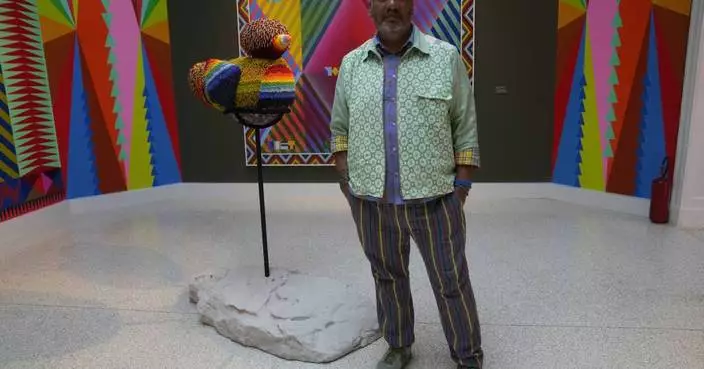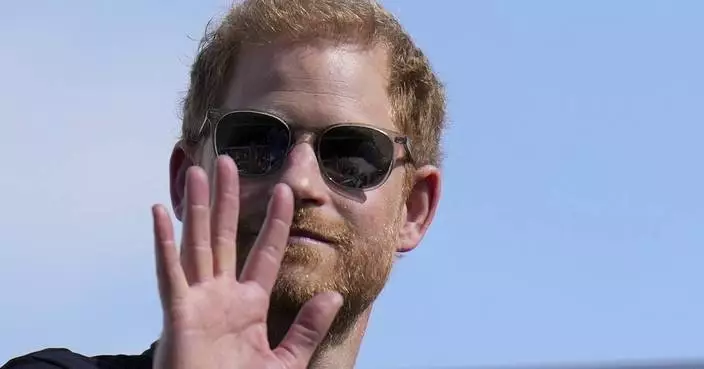When actor Billy Porter unveiled his combination tuxedo-ball gown at the Oscars last month, it got people talking.
Porter, the black and gay breakout star of the FX series "Pose," had bucked traditional Academy Award attire — fancy frocks for the ladies and basic tuxedos for men.
Click to Gallery
When actor Billy Porter unveiled his combination tuxedo-ball gown at the Oscars last month, it got people talking.
The show was inspired, in part, by what's happening right now in fashion, said Michelle Finamore, a fashion historian and curator.
One notable inclusion is the tuxedo that actress Marlene Dietrich wore in the 1930 film "Morocco."
The exhibit references the 1920s, a time when women first cut their hair short. Then it progresses to the 1960s and The Peacock Revolution, when menswear shifted from plain and simple to flamboyant, colorful and tailored to the body. The '60s is also when unisex attire became mainstream. And present day is thought to be the height of gender fluidity in fashion.
Today, as the world questions the very relevance of gender definitions, cultural questions are taking visual form in fashion, Paloetti said.
A photo of Porter's eye-catching Oscar garb is included in a new exhibit at Boston's Museum of Fine Arts that opens to the public on Thursday. The exhibit titled, "Gender Bending Fashion," examines moments in history when clothing transcended and muddled our understanding of gender.
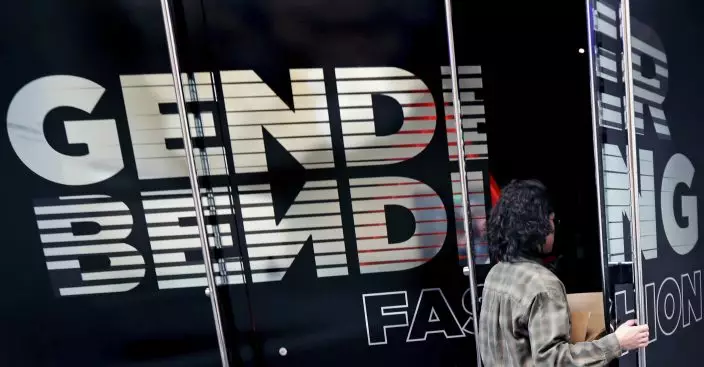
In this Thursday, March 14, 2019, photo, a worker enters the "Gender Bending Fashion" exhibit, being prepared at the Museum of Fine Arts in Boston, Thursday, March 14, 2019. The show opens to the public on Thursday, March 21, and runs through Aug. 25. It examines moments in history when clothing transcended and muddled our understanding of gender. (AP PhotoCharles Krupa)
The show was inspired, in part, by what's happening right now in fashion, said Michelle Finamore, a fashion historian and curator.
"The lines are getting more and more blurred," she said.
"Gender Bending Fashion" is the first large-scale exhibit of its kind to be hosted by a major museum. It is comprised of mixed-media: paintings, record covers and photographs. But a highlight for viewers will surely be the 70 gender-bending ensembles from big-name designers, such as Rei Kawakubo, of Comme des Garçons, and Walter Van Beirendonck, a member of the influential avant-garde group "Antwerp Six."

In this Thursday, March 14, 2019, photo, a suit worn by David Bowie, left, is displayed next to an ensemble worn by Jimi Hendrix for the "Gender Bending Fashion" exhibition at the Museum of Fine Arts in Boston. The new exhibit at the museum explores how blurring gender lines are redefining the fashion industry. The show opens to the public on Thursday, March 21, and examines moments in history when clothing transcended and muddled our understanding of gender. (AP PhotoCharles Krupa)
One notable inclusion is the tuxedo that actress Marlene Dietrich wore in the 1930 film "Morocco."
Dietrich has long been hailed as a hero for gender fluidity. It wasn't uncommon for her to wear top hats, shirts with French cuffs and cuff links, and pant suits tailored for men.
"She was both sides of the binary in that she was either extremely feminine or extremely masculine," Finamore said.

In this Thursday, March 14, 2019, photo, men's suit designed with flowers and birds is displayed for the "Gender Bending Fashion" exhibition at the Museum of Fine Arts in Boston. The new exhibit at the museum explores how blurring gender lines are redefining the fashion industry. The show opens to the public on Thursday, March 21, and examines moments in history when clothing transcended and muddled our understanding of gender. (AP PhotoCharles Krupa)
The exhibit references the 1920s, a time when women first cut their hair short. Then it progresses to the 1960s and The Peacock Revolution, when menswear shifted from plain and simple to flamboyant, colorful and tailored to the body. The '60s is also when unisex attire became mainstream. And present day is thought to be the height of gender fluidity in fashion.
Each of these moments represent a cultural shift within society, said Jo Paloetti, author of the books "Sex and Unisex: Fashion, Feminism, and the Sexual Revolution" and "Pink and Blue: Telling the Boys from the Girls in America."
In the 1920s, women secured the right to vote and started working outside the home for the first time. The 1960s brought the sexual revolution, gay rights and second-wave feminism — people pushing back against traditional roles.

In this Thursday, March 14, 2019, photo, a skirt for men is displayed on a mannequin for the "Gender Bending Fashion" exhibit at the Museum of Fine Arts in Boston. "Gender Bending Fashion" is the first large-scale exhibit of its kind to be hosted by a major museum. It is comprised of mixed-media: paintings, record covers and photographs. But a highlight for viewers will surely be the 70 gender-bending ensembles from big-name designers. (AP PhotoCharles Krupa)
Today, as the world questions the very relevance of gender definitions, cultural questions are taking visual form in fashion, Paloetti said.
"We are asking what it means to be man or woman," she said. "Are these terms just a proxy for stereotypes?"
The show is on display through Aug. 25.
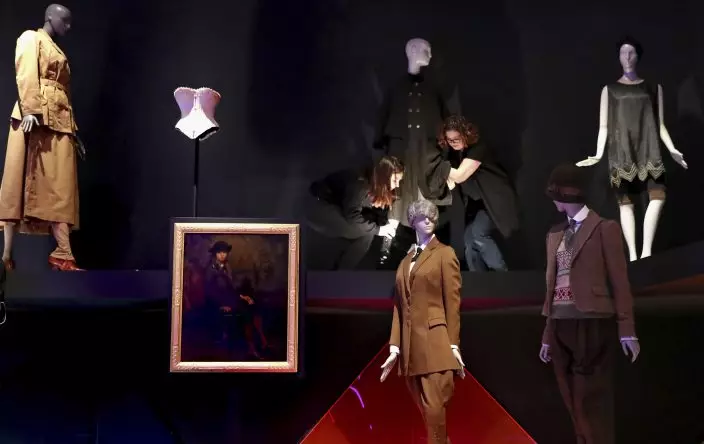
In this Thursday, March 14, 2019, photo, workers install a mannequin, which combines traditional designs for men with those for women, for the "Gender Bending Fashion" exhibition at the Museum of Fine Arts in Boston. The show was inspired, in part, by what’s happening right now in fashion, said Michelle Finamore, a fashion historian and curator. (AP PhotoCharles Krupa)
UNITED NATIONS (AP) — The United States vetoed a widely backed U.N. resolution Thursday that would have paved the way for full United Nations membership for Palestine, a goal the Palestinians have long sought and Israel has worked to prevent.
The vote in the 15-member Security Council was 12 in favor, the United States opposed and two abstentions, from the United Kingdom and Switzerland. U.S. allies France, Japan and South Korea supported the resolution.
The strong support the Palestinians received reflects not only the growing number of countries recognizing their statehood but almost certainly the global support for Palestinians facing a humanitarian crisis caused by the war in Gaza, now in its seventh month.
The resolution would have recommended that the 193-member U.N. General Assembly, where there are no vetoes, approve Palestine becoming the 194th member of the United Nations. Some 140 countries have already recognized Palestine, so its admission would have been approved, likely by a much higher number of countries.
U.S. deputy ambassador Robert Wood told the Security Council that the veto “does not reflect opposition to Palestinian statehood but instead is an acknowledgment that it will only come from direct negotiations between the parties."
The United States has “been very clear consistently that premature actions in New York — even with the best intentions — will not achieve statehood for the Palestinian people,” deputy State Department spokesman Vedant Patel said.
His voice breaking at times, Palestinian U.N. Ambassador Riyad Mansour told the council after the vote: “The fact that this resolution did not pass will not break our will and it will not defeat our determination.”
“We will not stop in our effort,” he said. “The state of Palestine is inevitable. It is real. Perhaps they see it as far away, but we see it as near.”
This is the second Palestinian attempt for full membership and comes as the war in Gaza has put the more than 75-year-old Israeli-Palestinian conflict at center stage.
Palestinian President Mahmoud Abbas first delivered the Palestinian Authority’s application for U.N. membership in 2011. It failed because the Palestinians didn’t get the required minimum support of nine of the Security Council’s 15 members.
They went to the General Assembly and succeeded by more than a two-thirds majority in having their status raised from a U.N. observer to a non-member observer state in 2012. That opened the door for the Palestinian territories to join U.N. and other international organizations, including the International Criminal Court.
Algerian U.N. Ambassador Amar Bendjama, the Arab representative on the council who introduced the resolution, called Palestine’s admission “a critical step toward rectifying a longstanding injustice" and said that “peace will come from Palestine’s inclusion, not from its exclusion.”
In explaining the U.S. veto, Wood said there are “unresolved questions” on whether Palestine meets the criteria to be considered a state. He pointed to Hamas still exerting power and influence in the Gaza Strip, which is a key part of the state envisioned by the Palestinians.
Wood stressed that the U.S. commitment to a two-state solution, where Israel and Palestine live side-by-side in peace, is the only path for security for both sides and for Israel to establish relations with all its Arab neighbors, including Saudi Arabia.
“The United States is committed to intensifying its engagement with the Palestinians and the rest of the region, not only to address the current crisis in Gaza, but to advance a political settlement that will create a path to Palestinian statehood and membership in the United Nations,” he said.
Mansour, the Palestinian U.N. ambassador, reiterated the commitment to a two-state solution but asserted that Israel believes Palestine "is a permanent strategic threat."
"Israel will do its best to block the sovereignty of a Palestinian state and to make sure that the Palestinian people are exiled away from their homeland or remain under its occupation forever,” he said.
He demanded of the council and diplomats crowded in the chamber: “What will the international community do? What will you do?”
Israeli-Palestinian negotiations have been stalled for years, and Israel’s right-wing government is dominated by hard-liners who oppose Palestinian statehood.
Israeli U.N. Ambassador Gilad Erdan called the resolution “disconnected to the reality on the ground” and warned that it “will cause only destruction for years to come and harm any chance for future dialogue.”
Six months after the Oct. 7 attack by the Hamas militant group, which controlled Gaza, and the killing of 1,200 people in “the most brutal massacre of Jews since the Holocaust,” he accused the Security Council of seeking “to reward the perpetrators of these atrocities with statehood.”
Israel’s military offensive in response has killed over 32,000 Palestinians, according to Gaza’s health ministry, and destroyed much of the territory, which speaker after speaker denounced Thursday.
After the vote, Erdan thanked the United States and particularly President Joe Biden “for standing up for truth and morality in the face of hypocrisy and politics.”
He called the Palestinian Authority — which controls the West Bank and the U.S. wants to see take over Gaza where Hamas still has sway — “a terror supporting entity.”
The Israeli U.N. ambassador referred to the requirements for U.N. membership – accepting the obligations in the U.N. Charter and being a “peace-loving” state.
“How can you say seriously that the Palestinians are peace loving? How?” Erdan asked. “The Palestinians are paying terrorists, paying them to slaughter us. None of their leaders condemns terrorism, nor the Oct. 7 massacre. They call Hamas their brothers.”
Despite the Palestinian failure to meet the criteria for U.N. membership, Erdan said most council members supported it.
“It’s very sad because your vote will only embolden Palestinian rejectionism every more and make peace almost impossible,” he said.

Algeria's Permanent Ambassador to the United Nations Amar Bendjama speaks during a Security Council meeting at United Nations headquarters, Thursday, April 18, 2024. (AP Photo/Yuki Iwamura)
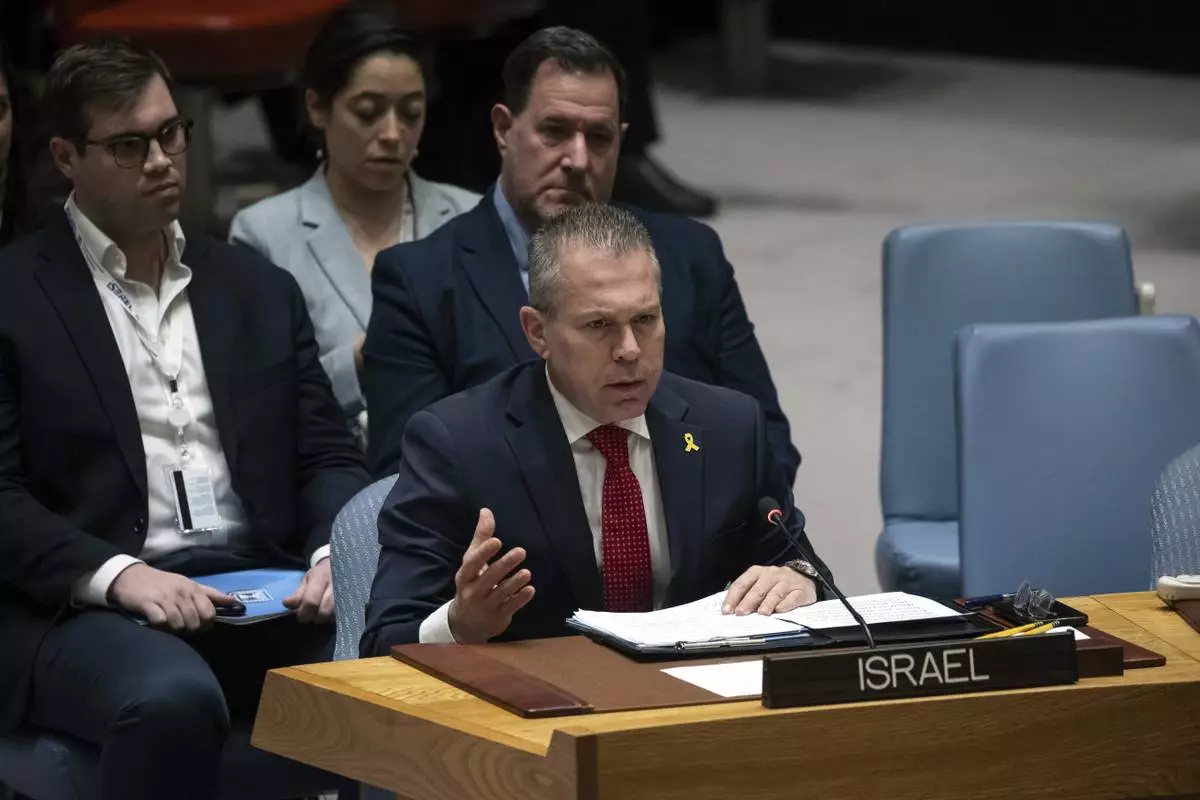
Israeli Ambassador to the United Nations Gilad Erdan speaks during a Security Council meeting at United Nations headquarters, Thursday, April 18, 2024. (AP Photo/Yuki Iwamura)

Palestinian Ambassador to the United Nations Riyad Mansour holds tears while speaking during a Security Council meeting at United Nations headquarters, Thursday, April 18, 2024. (AP Photo/Yuki Iwamura)

Representatives of member countries take votes during a Security Council meeting at United Nations headquarters, Thursday, April 18, 2024. (AP Photo/Yuki Iwamura)
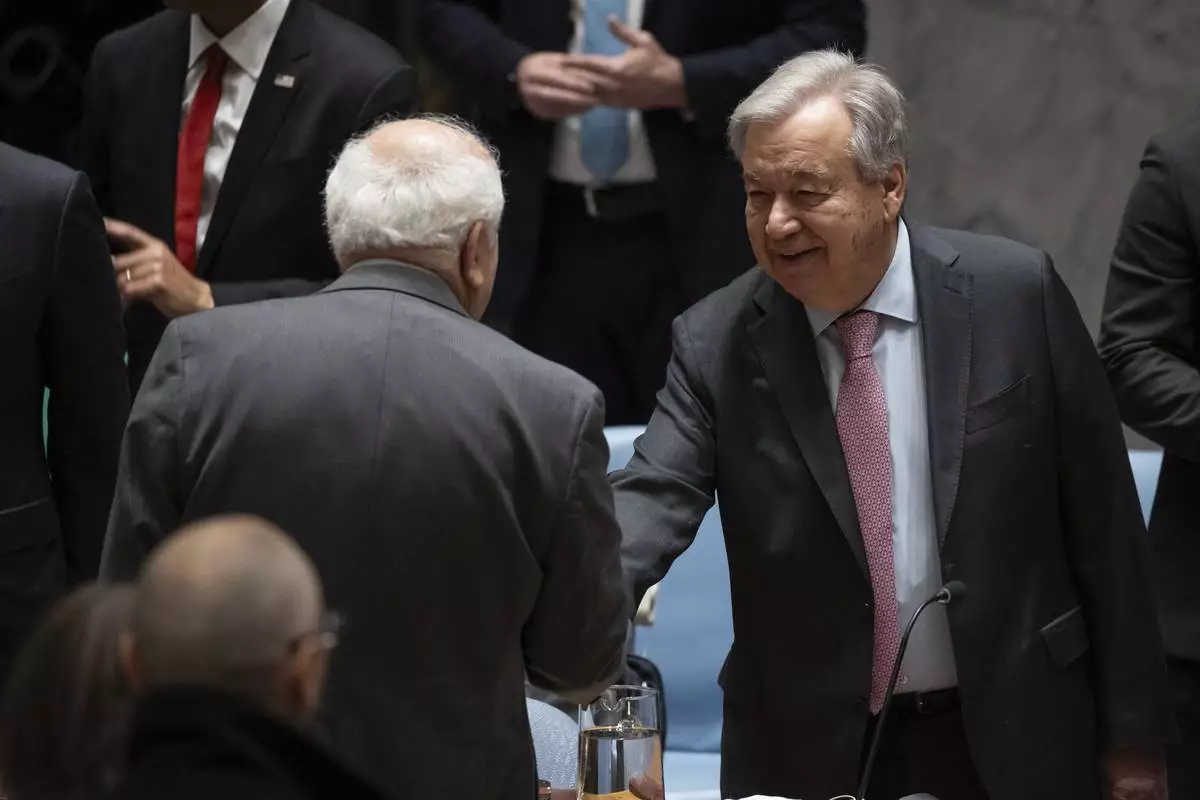
Palestinian Ambassador to the United Nations Riyad Mansour, left, and United Nations Secretary-General Antonio Guterres speak before a Security Council meeting at the United Nations headquarters, Thursday, April 18, 2024. (AP Photo/Yuki Iwamura)
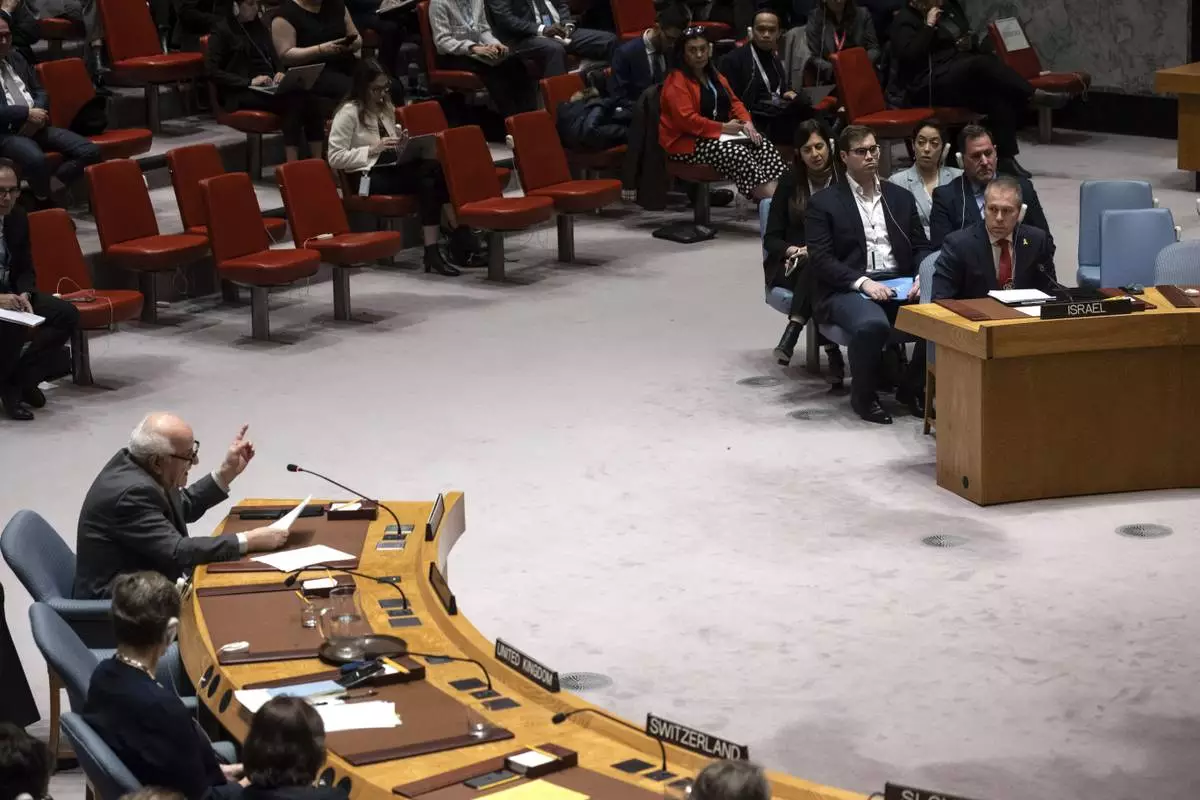
Palestinian Ambassador to the United Nations Riyad Mansour speaks during a Security Council meeting at United Nations headquarters, Thursday, April 18, 2024. (AP Photo/Yuki Iwamura)

Representatives of member countries take votes during a Security Council meeting at United Nations headquarters, Thursday, April 18, 2024. (AP Photo/Yuki Iwamura)

Israeli Ambassador to the United Nations Gilad Erdan speaks during a Security Council meeting at United Nations headquarters, Thursday, April 18, 2024. (AP Photo/Yuki Iwamura)
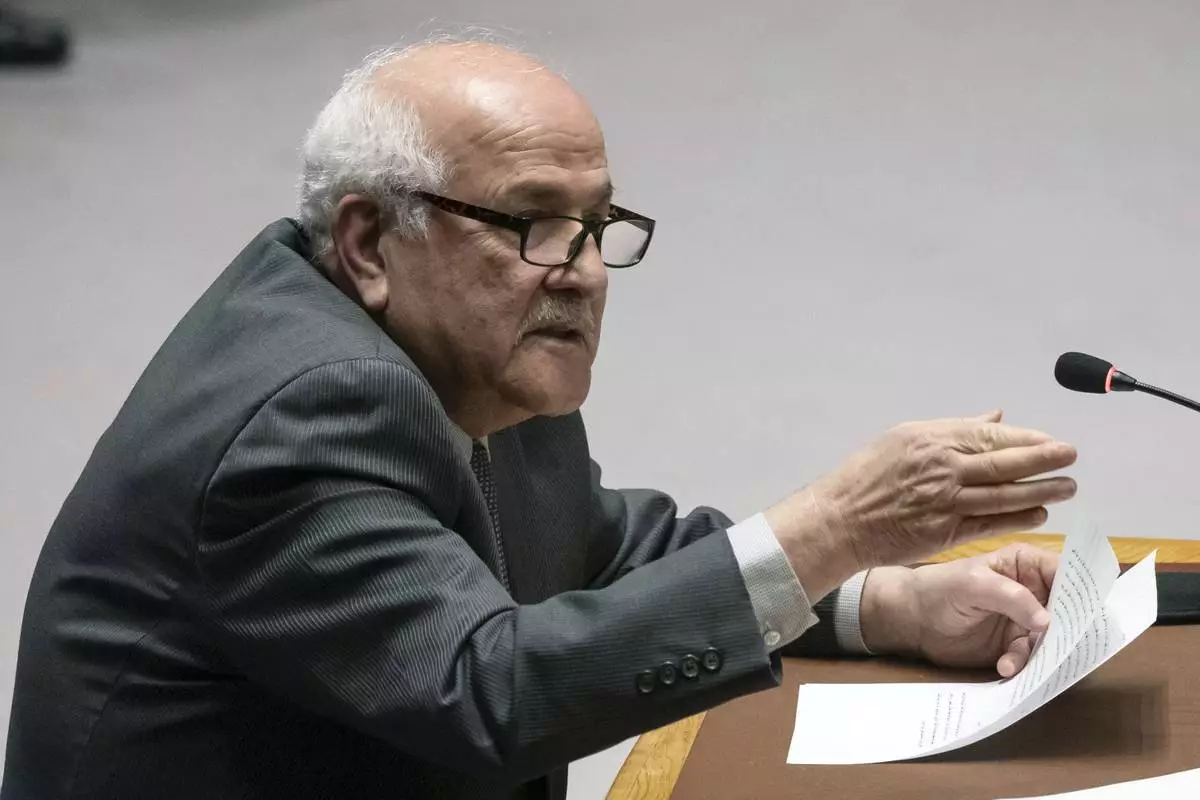
Palestinian Ambassador to the United Nations Riyad Mansour speaks during a Security Council meeting at United Nations headquarters, Thursday, April 18, 2024. (AP Photo/Yuki Iwamura)
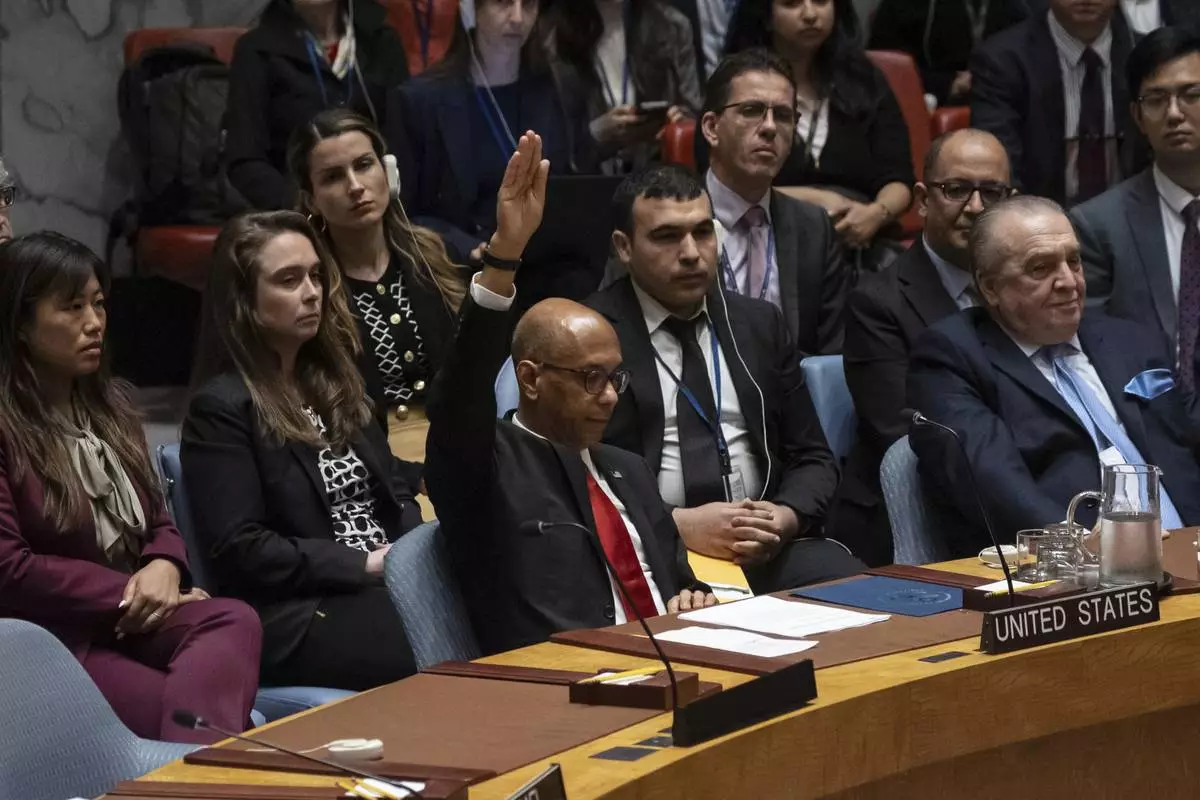
U.S. Deputy Ambassador Robert Wood votes against resolution during a Security Council meeting at United Nations headquarters, Thursday, April 18, 2024. (AP Photo/Yuki Iwamura)


















